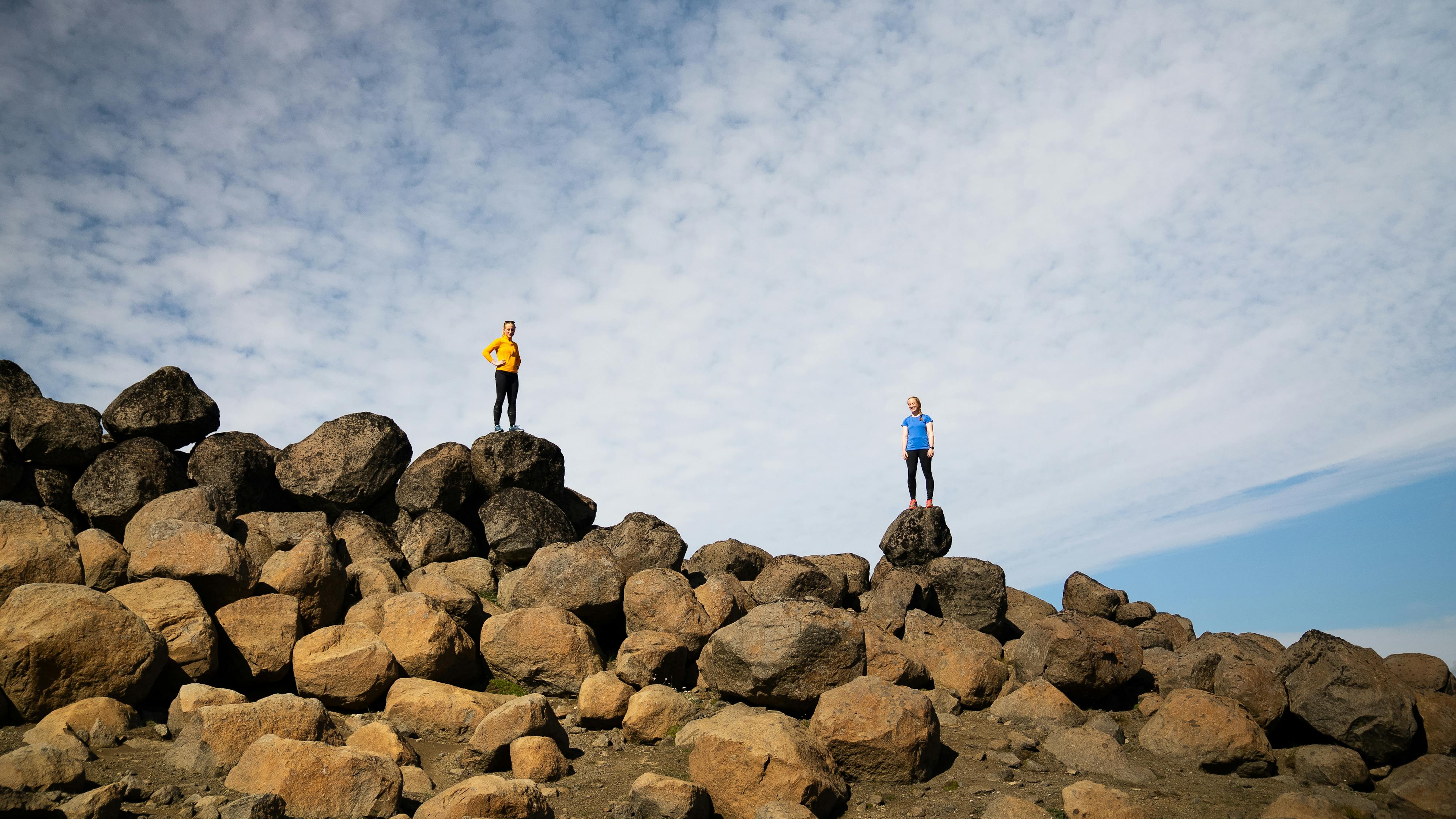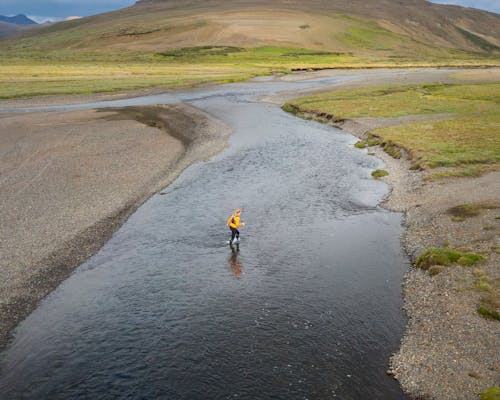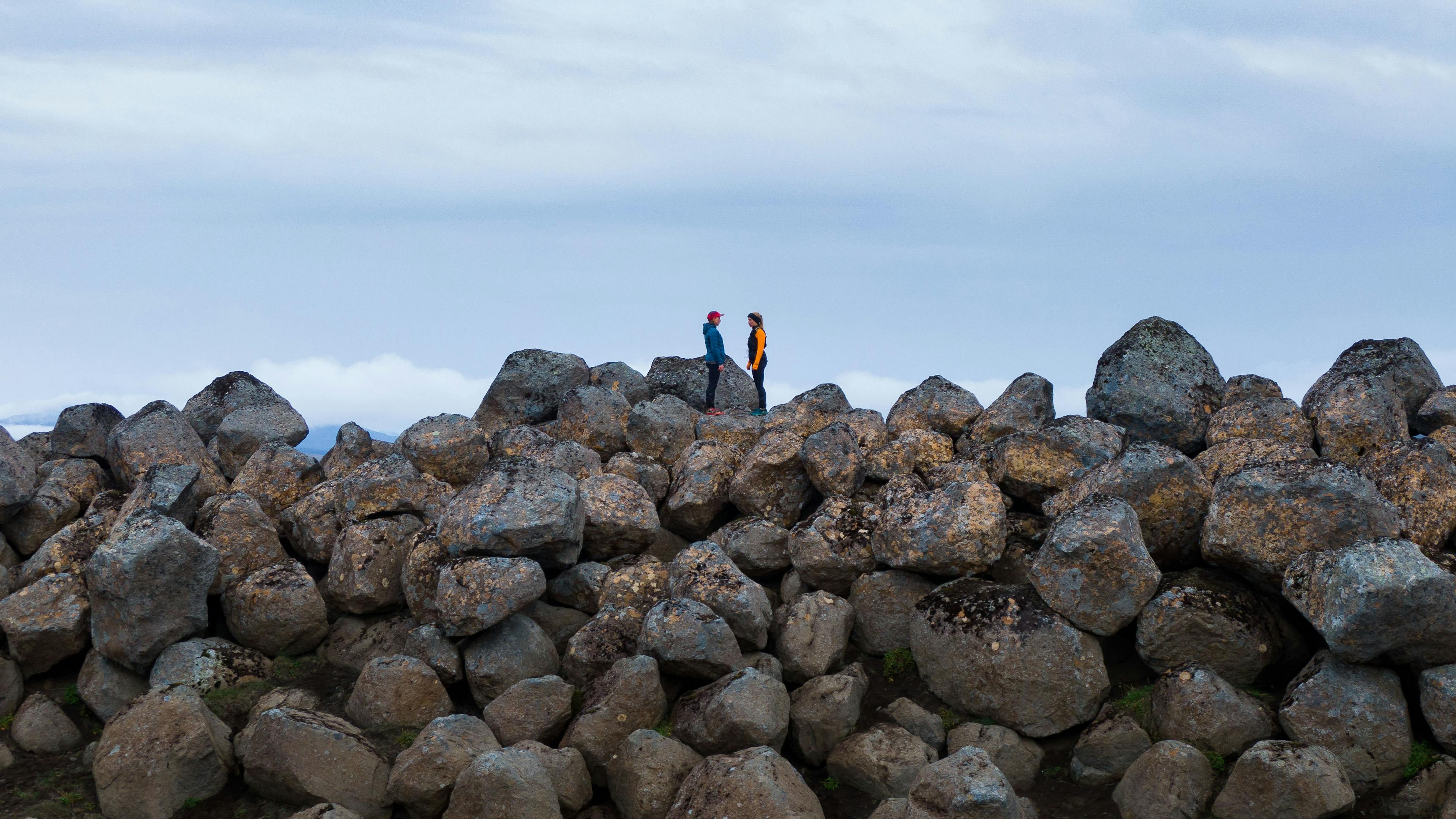
Védís og Halla
Troll Twins
"Troll Wall, Skessugarður in Icelandic, is a natural wonder at Jökuldalsheiði in the North-East highlands of Iceland. It is a long pile of huge moraine boulders on top of each other. According to legend it marks the border between troll territories. - This seems also to be the most logical explanation for its being there," says Halla

Troll Wall / Skessugarður
"I wanted to follow in the footsteps of the trolls who built the Troll Wall and meet my twin sister, Halla, in the middle of it," says Védís Ólafsdóttir.
"Troll Wall, Skessugarður in Icelandic, is a natural wonder at Jökuldalsheiði in the North-East highlands of Iceland. It is a long pile of huge moraine boulders on top of each other. According to legend, it marks the border between troll territories. - This seems also to be the most logical explanation for its being there," says Halla with a smile.
A folktale tells the story of two troll women who built a wall. One of the trolls lived down by the sea and the other inland, close to the glacier. Once, when they met, they started arguing about their territorial borders. They agreed that each of them owned half the land, but they could not agree on its midpoint. So, they decided that on a set day and set time, they would stride towards each other from each end of the land and at the point at which they met they would build a huge wall of boulders; the Troll Wall.
When Védís heard the folktale about Troll Wall she had an idea. "The trolls argued about borders and I can relate to that," says Védís, "I'm an identical twin but I've never been very good at being an identical twin. I haven’t been comfortable sharing space with my twin sister; we have continuously lived in different countries and different parts of the country. But maybe it's time to accept being an identical twin," says Védís, "and meet my sister on the wall."
I'm an identical twin but I've never been very good at being an identical twin




Some sections were along roads and trails, while others were over hills and meadows

The distance from Skessugarður to Brúarjökull Glacier in the south and from Skessugarður to the sea in Vopnafjörður to the north is very similar, 70 to 75 kilometers. Halla and Védís decided to put on their running shoes, follow in the footsteps of the trolls and run the same routes as the trolls in the folktale; towards each other.
It was at the end of summer, just before five o'clock in the morning, that Halla shook off the morning chill at Brúarjökull Glacier, packed up her tent and ran towards Védís, who set off at the same time from the coast in Vopnafjörður in the North.
Védís set off while the fjord was still half asleep. She said goodbye to the seabirds and ran past farms and fields with the town of Vopnafjörður disappearing behind her. As the sun crept up from behind the mountain only the occasional bleat and caw accompanied the rhythmic patter of her feet meeting the ground. Meanwhile, Halla made her way through the silence of the vast highlands north of Vatnajökull Glacier. From afar the mountains Snæfell and Herðubreið greeted her with composure.
They had a long day ahead. "Some sections were along roads and trails, while others were over hills and meadows. We crossed many swamps and rivers," says Halla. Unlike the trolls, the sisters were not in a race against time or sunlight and had agreed not to rush, but rather to enjoy their journeys. The long Icelandic summer day revealed the diversity in the landscape, from the glacier to the sea; hot springs, beautifully green valleys, mountain glory, birdlife and even reindeer.
We have a better relationship when we go our own way before meeting to share our stories

Védís ran along the river Hofsá before she headed for the moor Tunguheiði and then Jökuldalsheiði. She strode over meadows and marshes, between glittering mountain lakes. Geese prepared their migration and a single loon wailed on the water. An abundance of delicious blueberries and refreshing brooks kept her going.
"How much distance have you covered?" Védís asked Halla when she called to check in. "50 or 51 kilometers," she replied. "I'm at 52!" Exclaimed Védís. "Wow, we really are twins," said Halla.
Halla ran on in the vast highlands north of Vatnajökull Glacier but then dropped down into the beautifully green valley Laugarvalladalur, where she could bathe in a hot spring. On she went and waded the river in the valley, again and again, until she came to the end of the valley and returned to the moors where weather was getting worse.
"It was a strange feeling when I had run more than fifty kilometers, the furthest I’ve run, but still had an half marathon a head of me,” Halla says.

Halla's route turned out to be several kilometers longer than Védís' and go through the deep swamps. "I was worried that she was running a longer route and that it was more challenging," says Védís. „We had explored most of the route beforehand. The only unknown part was the last part of Halla's route." - "My concern for her was revealing to me, it reminded me that in general people always want the best for their loved ones, that’s most important," Védís says. Halla still had a few kilometers to go when Védís approached the Troll Wall from the north. "But I trusted," says Védís, "that she knew I would wait for her if I got there first." Which she did. Finally, after a 75 kilometer run, Védís saw Halla approaching from the south.
After running in solitude for hours on end the sisters welcomed their reunion at the wall. "It was sometimes a bit lonely running all that distance by myself," says Halla, "but I think it was better that we took separate paths. It’s exactly what works best in our lives. We have a better relationship when we go our own way before meeting to share our stories."
Troll Wall
What to wear
